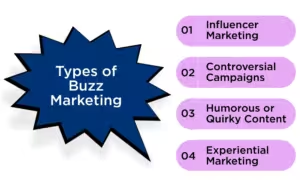Standing out in this digital world and crowded marketplace can be a real challenge. This is where Buzz Marketing steps in. An innovative and effective tactic, it seeks to create buzz, spark conversation, and position a brand or product as the focal point. But what exactly is Buzz Marketing? This blog will dive into its meaning, benefits, types, and some of the best examples in action.
What is Buzz Marketing?
Buzz Marketing is a viral marketing technique that focuses on creating hype around a product, service, or brand, often through unconventional means. It’s all about generating word-of-mouth excitement that spreads quickly, capturing the interest of a large audience. Whether through social media, influencers, or even shocking or humorous campaigns, the goal of Buzz Marketing is to get people talking and sharing with their friends and followers.
The key here is to evoke strong emotional responses—be it laughter, surprise, or curiosity—that compel consumers to engage with the content and pass it on to others. In essence, it’s the “water cooler conversation” that takes place online, when a product or message becomes the most often discussed topic.
Benefits of Buzz Marketing
When done right, Buzz Marketing offers several significant advantages. Let’s explore the top benefits:
- Cost-Effective Advertising
Unlike traditional advertising, which can be expensive, Buzz Marketing relies on word-of-mouth and viral sharing. It only takes a brilliant idea that connects with people to have an impact; a large budget is not necessary.
2. Increased Brand Awareness
Focusing attention on your brand is one of Buzz Marketing’s main goals. When people start talking about your product or service, it increases visibility, helping you reach potential customers who might have been unaware of your brand.
- High Engagement
Campaigns that use Buzz Marketing often see a high level of engagement. Whether through social media comments, shares, or reactions, consumers are eager to participate and share the experience, which can drive more traffic and sales.
- Fosters Trust and Credibility
Word-of-mouth recommendations are among the most trusted forms of marketing. People are more inclined to try a product when they learn about it from trusted influencers or their peers. Buzz Marketing leverages this trust to build credibility for the brand.
Types of Buzz Marketing
There are various approaches to Buzz Marketing, each tailored to generate excitement in different ways. Here are some common types:
- Influencer Marketing
Using influencers to create buzz is one of the most popular methods today. Influencers have loyal followers who trust their opinions, and when they promote a product or service, it creates immediate attention.
- Controversial Campaigns
Sometimes, brands create controversy to get people talking. While this can be risky, it often leads to widespread attention if handled properly. The key is to ensure the controversy isn’t damaging to the brand but provocative enough to spark debate.
- Humorous or Quirky Content
Content that is humorous or eccentric has the potential to become viral. Whether through memes, clever videos, or playful messaging, brands can use humor to encourage consumers to share their content widely.
- Experiential Marketing
This type of Buzz Marketing creates unique, often live, experiences that encourage consumers to engage directly with a product or service. These events generate conversation and often lead to viral sharing through social media posts or news coverage.
Best Examples of Buzz Marketing
Several companies have effectively used Buzz Marketing to capture consumer attention and dominate conversation. Some of the better instances are as follows:
1. Old Spice’s “The Man Your Man Could Smell Like”
This humorous and highly shareable campaign from Old Spice went viral almost immediately after its release. With its quirky, over-the-top humor and charming spokesperson, the brand became a topic of conversation across social media platforms, significantly boosting its sales.
- ALS Ice Bucket Challenge
A perfect example of a viral Buzz Marketing campaign, the ALS Ice Bucket Challenge took the internet by storm. Participants splashed themselves with buckets of ice-cold water and nominated others to do the same in an attempt to increase awareness about ALS. It spread rapidly across social media, raising millions for charity.
- Red Bull Stratos
Red Bull’s Stratos project, where Felix Baumgartner jumped from the edge of space, captivated millions around the world. This awe-inspiring event generated immense buzz and showcased Red Bull’s brand identity as a company that supports extreme sports and challenges.
Conclusion
Buzz Marketing is an innovative, attention-grabbing strategy that has proven effective for brands looking to make a splash. By focusing on creativity, emotional appeal, and the power of word-of-mouth, businesses can drive immense engagement and brand recognition without breaking the bank. Whether through influencers, humor, controversy, or live events, the key to a successful Buzz Marketing campaign is finding a unique angle that gets people talking. And when people talk, brands thrive.
If you’re looking for a way to elevate your brand and capture consumer interest, consider how Buzz Marketing can become part of your strategy. It could be the buzz you require!
Recommended For You:


